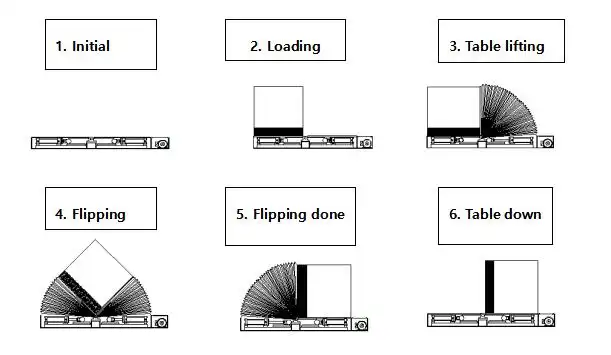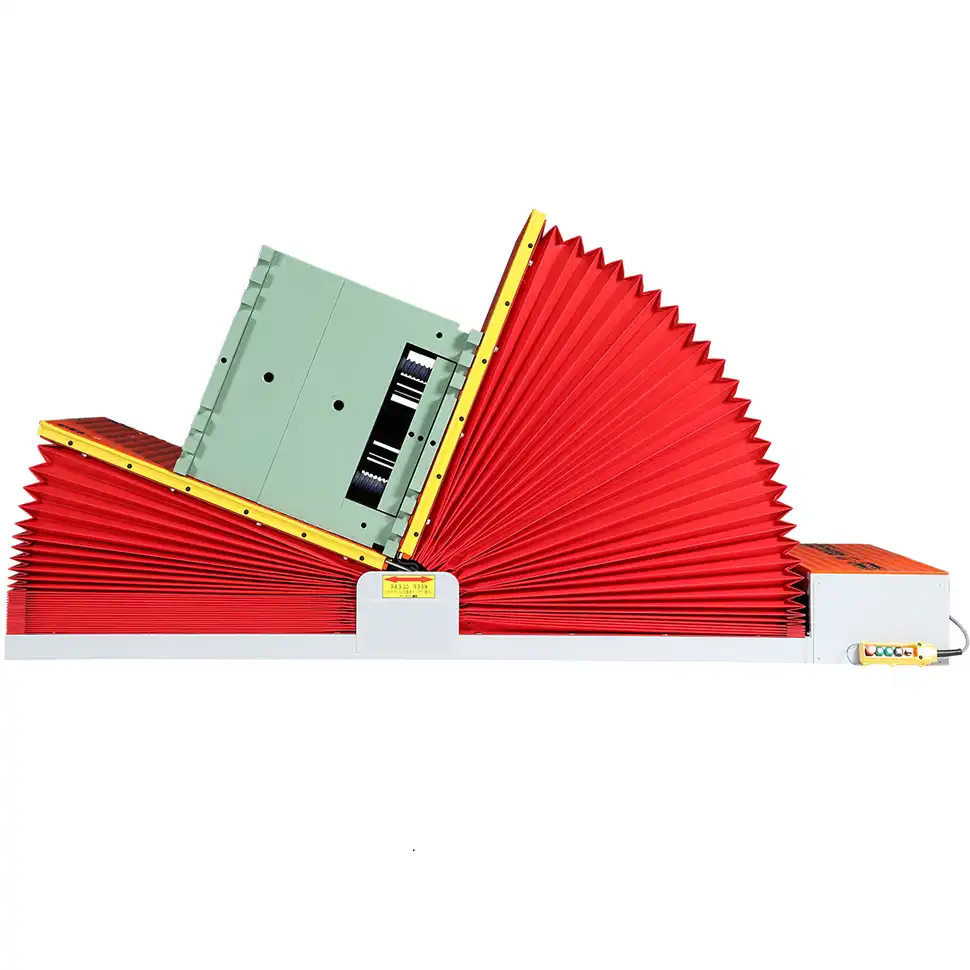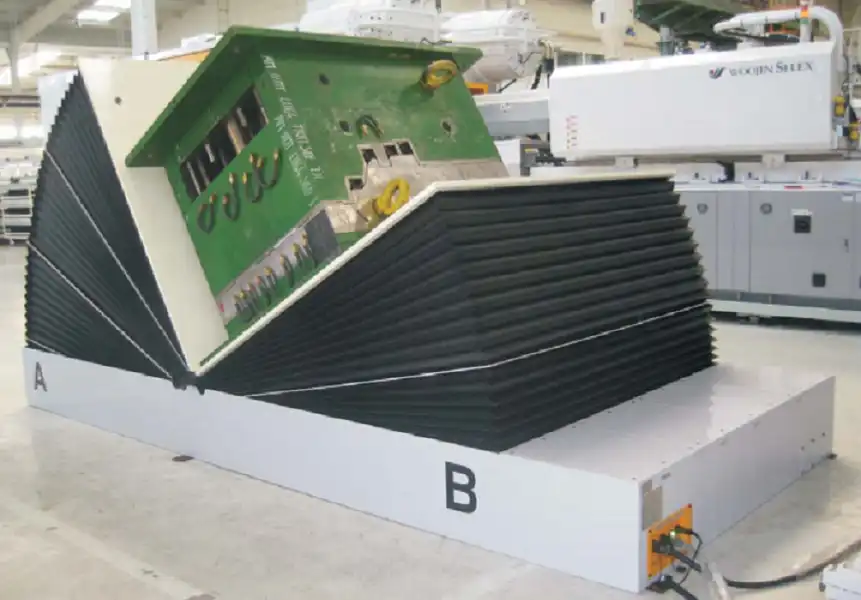Mold flipper: can operator training be completed within a day in Indonesia?
You have just made a significant investment in a new mold flipper. This machine is a beast, designed to improve safety and efficiency in your workshop. But there's a problem. A powerful machine is useless without a skilled operator. You worry about long training periods, which mean extended downtime, lost production, and frustrated staff members. Every day the machine sits idle or is operated incorrectly, you are losing money. In a competitive market like Indonesia, these delays are not an option. What happens if your main operator gets sick or finds a new job? You are forced to start the difficult training process all over again. But what if I told you that operator training does not have to be a major roadblock? What if a new employee could become a confident, safe, and efficient operator in just a single day? This is not a dream. It is the new standard for modern industrial equipment.
Yes, with a modern, user-friendly mold flipper, operator training can absolutely be completed within a single day in Indonesia. This is possible due to intuitive machine design, simplified control systems, and comprehensive, structured training programs provided by the manufacturer. The focus is on making the machine's operation so logical that a new user can gain proficiency and confidence quickly and safely.

I know that claim might sound bold. When I first started as an engineer in a packing machine factory, training on new equipment could take weeks. It was a long process of trial and error. But I have seen the technology evolve. Over my journey from employee to factory owner, I have personally helped clients across Asia, including in Indonesia, get their teams up and running on our machines in record time. It is a game-changer for their entire operation. Let’s explore exactly how this is possible and what it means for your business.
What makes a mold flipper so easy to learn?
You look at a piece of heavy industrial machinery, and you expect complexity. A panel full of confusing buttons, levers with unclear functions, and a long manual can be overwhelming for any new operator. This complexity is not just intimidating; it is dangerous. It leads to mistakes, slows down the workflow, and can even cause serious accidents. It also means your most experienced engineers and supervisors are tied up for days, teaching the basics instead of focusing on more valuable tasks. But modern engineering has a simple goal: to remove that complexity. The best mold flippers today are designed with the user in mind, making them feel as intuitive as a smartphone.
A mold flipper is easy to learn because of its simplified controls, clear visual indicators, and built-in safety interlocks. The entire design philosophy is focused on minimizing the chance for operator error. We make the correct way to operate the machine the easiest and most natural way.

When I founded SHJLPACK, one of my core principles was to build machines that empower the operator, not intimidate them. I remembered my early days on the factory floor, feeling nervous about pressing the wrong button. That experience shaped how we approach design today. It is about creating a seamless connection between the human and the machine.
The Core of Simplicity: User-Centric Design
The heart of an easy-to-learn machine is its Human-Machine Interface (HMI). Old machines often had rows of identical-looking switches. The operator had to memorize long, complex sequences. One small mistake could force them to start over or, worse, cause a problem. Today, we use clear, touchscreen displays with graphical icons. The workflow is presented visually on the screen. An operator does not need to memorize steps; they just follow the logical progression shown on the HMI. For example, buttons are often color-coded: green for 'start' or 'go', yellow for 'pause' or 'caution', and red for 'stop'. It seems simple, but these small details remove hesitation and build confidence.
Safety Features as a Built-in Teacher
A well-designed mold flipper uses its safety system as a training tool. For instance, safety interlocks physically prevent the machine from operating if a guard is open or if a mold is not properly secured. Limit switches stop the machine from moving beyond its designated safe range. Alarms with clear text descriptions on the HMI tell the operator exactly what is wrong. This system does more than just prevent accidents. It actively teaches the operator the correct procedures. They learn the machine's limits and requirements not by reading a dense manual, but by interacting with the machine itself. This hands-on, guided experience is incredibly effective and much faster than traditional methods.
| Feature | Old Generation Flipper | SHJLPACK Modern Flipper |
|---|---|---|
| Control Panel | Complex array of buttons and switches | Simple touchscreen HMI with graphics |
| Safety System | Basic emergency stop button | Integrated safety interlocks, light curtains, alarms |
| Operator Feedback | Limited to basic lights or buzzers | Clear text and visual alerts on screen |
| Workflow | Operator must memorize sequences | Visually guided, step-by-step process |
| Typical Training Time | 3-5 days | Less than 1 day |
This user-focused approach means you are not just buying a machine. You are investing in a system designed for rapid integration and immediate productivity.
How does one-day training impact factory ROI in Indonesia?
When you consider buying new equipment, you naturally focus on the purchase price and its potential output. These are critical numbers for calculating your Return on Investment (ROI). But many business owners overlook the "hidden" costs of implementation. How much does it really cost to get that new machine fully integrated into your production line and contributing to your bottom line? A long training cycle is a major hidden cost. Every day spent in training is a day the machine is not producing revenue. In a fast-moving and competitive manufacturing environment like Indonesia, speed to market is a massive advantage. Delays can mean failing to meet a customer deadline or losing an order to a more agile competitor. This is where one-day training changes the entire ROI calculation. It drastically shortens the machine's "time-to-value," meaning your investment starts paying for itself almost immediately.
The impact of one-day training on factory ROI in Indonesia is immediate and significant. It reduces initial labor costs, minimizes production downtime during integration, and increases operational flexibility, allowing the machine to generate revenue from the second day of its arrival.

I once worked with a client in Jakarta who ran a busy tool and die shop. They purchased one of our mold flippers to improve safety and speed up their mold maintenance process. They were worried because a big order was due, and they couldn't afford a week of downtime for installation and training. I personally assured them we could have their team ready in a day. They were skeptical. We arrived on a Monday. By Tuesday morning, their own operator was running the machine solo, and they were back to full production. The manager later told me that the single day of training saved them from a penalty for a late shipment. That is a direct, measurable impact on the bottom line.
Calculating the True Cost of Training
Let's break down the real costs. It's not just the salary of the trainee. It's the salary of your senior engineer or supervisor who is conducting the training. It's the value of the lost production while the machine is offline. If a machine can generate $1,000 in value per day, a five-day training period costs you $5,000 in lost opportunity before the machine even starts working. Reducing that training to a single day saves $4,000 instantly. For a large steel mill owner like Javier Morales, who deals with massive outputs, these numbers are magnified significantly.
The Flexibility Advantage in the Indonesian Market
The Indonesian labor market is dynamic. Having only one person who knows how to operate a critical machine is a huge business risk. What if they are on leave? What if they resign? Rapid training allows you to easily cross-train multiple employees. When anyone on the team can step in and operate the mold flipper safely, you create a more resilient and flexible operation. This agility is a key competitive advantage, allowing you to adapt to market demand fluctuations and keep production lines moving smoothly.
| Cost Factor | One-Week Training (5 days) | One-Day Training | Savings |
|---|---|---|---|
| Lost Production Opportunity | $5,000 | $1,000 | $4,000 |
| Supervisor Training Time | $800 (40 hrs @ $20/hr) | $160 (8 hrs @ $20/hr) | $640 |
| Trainee Non-Productive Wages | $400 (40 hrs @ $10/hr) | $80 (8 hrs @ $10/hr) | $320 |
| Total Implementation Cost | $6,200 | $1,240 | $4,960 |
As you can see, the savings are substantial. Fast training is not just a convenience; it is a powerful financial strategy.
When something sounds too good to be true, it is wise to be cautious. Can an operator really learn everything they need to know in a single day without cutting corners? It is a fair question. Rushing the training process could lead to a shallow understanding of the machine. An operator might learn which buttons to press for a standard task but have no idea what to do if something unexpected happens. They might overlook crucial daily safety checks or basic maintenance procedures. Over time, this could lead to preventable machine damage or, far worse, a serious workplace accident. The risk, however, is not in the speed of the training itself. The risk lies in the quality and completeness of the training program and the ongoing support from your equipment supplier.
Yes, there are potential risks with rapid operator training if it is not structured properly. These include overlooking critical safety procedures, a lack of understanding of maintenance needs, and an inability to handle non-standard situations. These risks are fully mitigated by a comprehensive, hands-on training module and a commitment to ongoing support from a reliable supplier.

This is where the difference between a simple equipment seller and a true strategic partner becomes clear. A seller drops the machine off and leaves you with a manual. A partner stays until your team is confident and remains available to help. My mission with SHJLPACK is to be that partner. We are a knowledge-sharing platform first and a machine builder second. We succeed only when our clients operate our equipment safely and productively.
Beyond the Buttons: Comprehensive Training Modules
A proper one-day training program is intense and well-structured. It is not just about showing someone the 'on' switch. Our on-site training covers four key areas:
- Theory: A brief session explaining why the machine works the way it does. Understanding the basic principles of mechanics and safety helps in troubleshooting later.
- Safety First: A detailed walkthrough of every single safety feature. The operator must demonstrate they know how to use the emergency stop, what the safety curtains are for, and how the interlocks work.
- Hands-On Operation: The majority of the day is spent actually using the machine with test molds under the direct supervision of our technician. We cover all standard operating procedures.
- Daily Care: We teach the operator the simple daily and weekly maintenance checks they are responsible for, like lubrication and inspection. This prevents small issues from becoming big problems.
The Supplier's Ongoing Responsibility
The one-day training is just the beginning of the relationship. A good supplier provides a safety net. At SHJLPACK, we provide all our clients with clear, illustrated manuals, detailed video tutorials for common tasks, and direct access to our technical support team. If an operator in Indonesia has a question a month after training, they can send us a video of the issue and get a quick response. This ongoing support ensures that learning continues long after our technician has left their facility.
| Potential Risk | Mitigation Strategy | Responsibility |
|---|---|---|
| Incomplete Safety Knowledge | Hands-on demonstration of all safety features; mandatory safety checklist. | Joint (Supplier & Customer) |
| Poor Maintenance Habits | Provide a simple, visual daily/weekly maintenance schedule. | Supplier provides, Customer implements |
| Inability to Troubleshoot | Training on common error messages; provide clear troubleshooting guide. | Supplier |
| Operator Complacency | Emphasize a culture of safety; offer refresher training materials (videos). | Joint (Supplier & Customer) |
By addressing these risks head-on, we ensure that rapid training is also safe and effective training.
Can the training process be standardized for different types of mold flippers?
Your factory is a complex ecosystem. You might have several production lines, each with unique needs. For one area, you might need a small 10-ton mold flipper. For your main line, you might require a heavy-duty 50-ton flipper. If each machine has a completely different control system and operating philosophy, you create a major operational headache. It complicates training, increases the likelihood of human error when operators switch between machines, and makes your workforce less flexible. It creates isolated islands of knowledge within your team. The ideal solution is to have a standardized approach. A supplier who builds their entire product line on a consistent design philosophy ensures that once your team learns one machine, they have a huge head start on learning all the others.
Yes, the training process can and should be standardized across different types of mold flippers, especially when they are sourced from a single, quality manufacturer. By using a consistent control interface, safety logic, and operating procedure, standardization dramatically reduces the learning curve for any new equipment you introduce.

I remember a client in the steel industry who was growing rapidly. They bought their first 20-ton mold flipper from us. Their team was trained in a day. A year later, their business had expanded, and they needed a 60-ton machine for a much larger product. They were concerned about the new training required. I explained that because they were buying from us again, the new machine would feel instantly familiar. The HMI was the same, the safety principles were the same, and the workflow was the same. The only difference was the scale. Their senior operator felt comfortable with the new, larger machine in less than two hours. That is the power of standardization.
The Power of a Unified HMI
The Human-Machine Interface (HMI) is the key. When all your mold flippers, regardless of size or capacity, share the same HMI, you create a universal language for your operators. Think about using a new smartphone. If you stay with the same brand, you already know how the operating system works. You don't have to re-learn the basics. This same principle applies to industrial machinery. A unified HMI means less training time, fewer errors, and the ability to move operators between different production lines as needed to meet demand. This aligns perfectly with the goals of a forward-thinking leader like Javier Morales, who is pushing for digitalization and efficiency.
Scalable and Modular Training Programs
Standardization allows for a more efficient training strategy. We can create a core training module that covers 90% of what an operator needs to know for any machine in our lineup. Then, we add a short, specific module for the unique features of a particular model. For example, the core training covers safety, controls, and basic operation. A supplemental module for a 50-ton machine might cover specific rigging points or advanced control features not present on a 10-ton model. This modular approach respects your team's time and focuses only on teaching what is new and relevant.
| Aspect | Standardized Approach (e.g., SHJLPACK) | Non-Standardized Approach |
|---|---|---|
| New Machine Training Time | 1-2 hours for a familiar operator | 1-2 days, starting from scratch |
| Operational Flexibility | High: Operators can easily switch between machines | Low: Operators are tied to one machine type |
| Safety Consistency | Uniform safety procedures across all equipment | Varies by machine, increasing risk of confusion |
| Maintenance Procedures | Similar checklists and components, simplifying upkeep | Different procedures for each machine, complicating maintenance |
For any factory owner planning for growth, choosing a supplier with a standardized equipment platform is a critical strategic decision that pays dividends for years to come.
Conclusion
Fast, effective training is not a bonus; it is a core business strategy. The right mold flipper makes one-day training a reality, turning your investment into profit faster.




